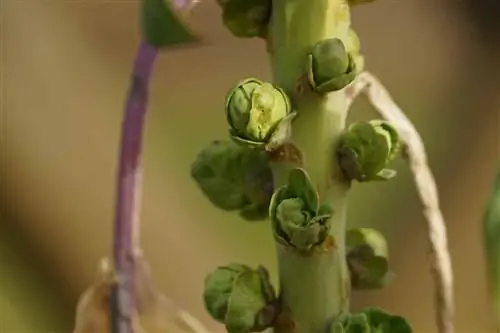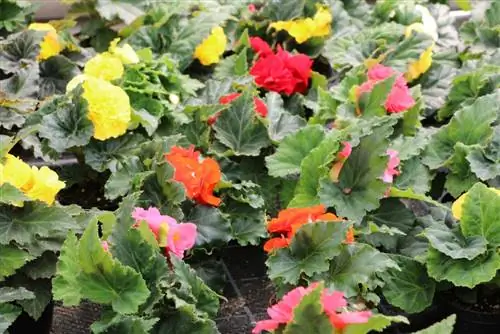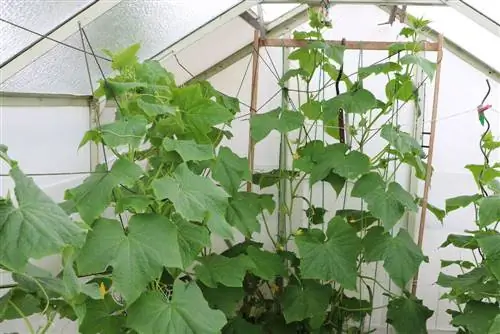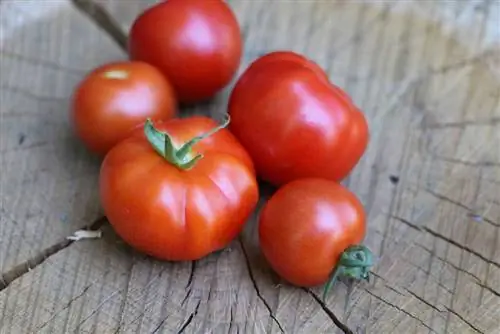- Author admin [email protected].
- Public 2023-12-17 03:39.
- Last modified 2025-06-01 06:48.
Brussels sprouts may not be many people's favorite foods, but as a winter vegetable they are a he althy addition to the cold season. All the better if it can be harvested in your own garden as needed. However, you need to have some knowledge to grow Brussels sprouts plants, because the plants are heavy feeders with one or another requirement when it comes to care and conditions. Interested hobby gardeners can find out what is required for a successful Brussels sprout harvest in the following instructions.
Location
The Brussels sprouts are quickly satisfied with their location. However, for optimal yield and strong plants, it should be in a sunny place that is somewhat sheltered. Crop rotation should also be taken into account. Since Brussels sprouts themselves are heavy feeders, the bed chosen should not have been used as a growing area for other heavy feeders in the previous three years.
Substrate
The substrate for growing Brussels sprouts must be rich in nutrients, humus and yet loose. Garden or vegetable soil enriched with compost and loosened with sand is ideal.
Prepare the bed
In order for Brussels sprouts to thrive right from the start, they need optimal conditions in the bed. The best way to do this is to spread plenty of well-rotted compost on the bed in the fall before you plan to plant the Brussels sprouts. The natural fertilizer is then worked in by digging up or simply raked in if the soil is already loose. Anyone who misses this point can catch up on the measure in the spring. Then at least two, and preferably four, weeks should pass before the Brussels sprouts are planted. During this waiting period, the nutrients are distributed more evenly in the soil and settle. In addition, important processes take place in the substrate with the help of various soil inhabitants. This creates optimal conditions in the soil. If the soil tends to become compacted, it is recommended to add the sand mentioned above to loosen it up. You should mix in enough to create a moist, crumbly structure.
variety selection
Depending on when the Brussels sprouts are to be harvested, different varieties come into consideration. Basically, Brussels sprouts plants are divided into early and late varieties. For some, a harvest is possible as early as September, for others only in December. Especially if the way to the garden involves a journey, you should carefully consider whether winter varieties are the right choice - because the Brussels sprouts harvest should be as spread out as possible.
More early varieties of Brussels sprouts
- Early Tall Half
- Falstaff
- Nelson
- Predora
- Hossa
- Wilhelmsburger
With these, you have to pay close attention to whether they are frost-resistant varieties or not. Brussels sprouts plants do not always ripen very early, which means that the harvest must be completed early. However, no exposure to cold is necessary to achieve the sweet taste.
Late and recommended varieties
- Boxers
- Gronninger
- Hild's Ideal
- Igor
- Harald
- Fortress
Pre-breeding
The Brussels sprouts can be sown directly into the bed, but better results can be achieved by growing them indoors early. The procedure is as follows:
- The potting soil is placed in small plant pots or - more practical - in pot plates.
- The Brussels sprout seeds are placed two or three times in each pot and lightly covered with soil.
- The substrate is moistened well but not washed away.
- Prepared in this way, the cultivation containers are placed in a bright place. The ideal germination temperature depends on the respective variety.
- In the first three to four weeks, the substrate should be kept slightly moist but never wet. A cover is not necessary.
The ideal time for pre-germinating the seeds is in early spring or - again depending on the variety - in late winter. February or March is optimal for most Brussels sprouts.
Cultivation
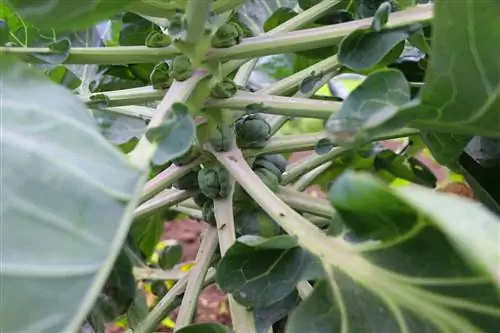
Between April and May, outdoor cultivation can begin; for this purpose, the early plants are first pricked out. Only the strongest specimens should be planted. The procedure is then as follows:
- A distance of 50 centimeters is marked out in the row and between the rows.
- The Brussels sprouts plants are planted individually and watered well.
- To stabilize the plants and make harvesting easier, a simple wooden frame can be built. Two stakes are inserted vertically at the beginning and end of each row. A connecting rod is placed on top and secured.
- Another pole can be connected to the framework from each plant. This construction protects the Brussels sprouts from wind damage and also has another practical use in protecting the plants.
- Prepared in this way, the plants tend to be kept dry after the initial watering. The following waterings are carried out regularly but at greater intervals. This stimulates the roots to grow deeper.
Pouring
If the Brussels sprout plants have grown well after the first three to four weeks and have developed strong roots due to the initially cautious watering, the plants need a little more moisture. Especially during growth in summer, it is important to water frequently and, if possible, not to let the soil dry out.
Tip:
If you use pond water and plant manure in summer, you can combine watering with fertilizing. A mulch layer of grass clippings further reduces evaporation and the maintenance effort.
Fertilize
The high nutrient requirements of Brussels sprouts and the long time until harvest may make it necessary to fertilize the bed again. As already mentioned, plant manure, for example from nettles, and pond water can be used without chemical additives. Compost, horse manure, grass clippings and horn meal can also be used. If the bed is sufficiently prepared with nutrients, fertilization is sufficient, around August.
Tip:
Overwatering or persistent rain can wash out nutrients and cause growth spurts that promote deficiency. If the leaves become discolored, you should fertilize again - no matter when.
Plant protection
Flea beetles, sawflies, cabbage flies and cabbage white butterflies can cause problems for Brussels sprouts. But before it even gets to that point, the cultivation can be appropriately protected against pests. It is advisable to use close-meshed protective nets that are stretched directly over the plants or the scaffolding described above. If it lies on the wooden frame, checking underneath is much easier. Just like the harvest. Keeping the soil moist throughout, as well as a layer of mulch and the application of plant manure help protect against flea beetles.
Tip:
The greater the distance between the individual Brussels sprout plants, the lower the risk of pest infestations and diseases.
Harvest
Depending on the variety, the Brussels sprout harvest can begin as early as September or extend into March of the following year. A complete harvest of the individual plants is neither necessary nor sensible. It is cheaper to pick as needed instead. The largest tubers are twisted off. These should each be two to four centimeters in diameter. Late varieties, which, like Hilds Ideal, are only harvested in winter, require a longer cold period for the pleasant and slightly sweet taste. Only the combination of sun and cold ensures increased storage of sugar, as it is no longer converted into starch or is converted into starch at a very slow rate. In order for the sugar to accumulate in the Brussels sprouts, the tubers must remain on the plant. So it's not enough to simply freeze them after harvest. This is different with Brussels sprouts plants, which ripen early. The Nelson variety, for example, can be harvested from September onwards. Not only do they not need frost, they can hardly tolerate it or not at all. The reason for this is that more sugar is stored in the small tubers anyway. So the taste is sweet anyway. It should be noted that the harvest must be weather-dependent. In the event of persistent or severe frost, all Brussels sprouts must be harvested as quickly as possible before they die.
Conclusion
Growing Brussels sprouts in your own garden is easily possible if a few points are taken into account during preparation and care. If you have the necessary knowledge and choose the right variety, even a beginner in gardening and vegetable cultivation can quickly achieve large yields and harvest fresh winter vegetables as needed for a long time during the cold season.

